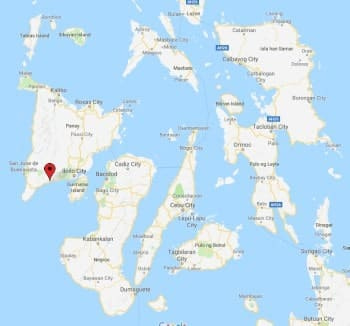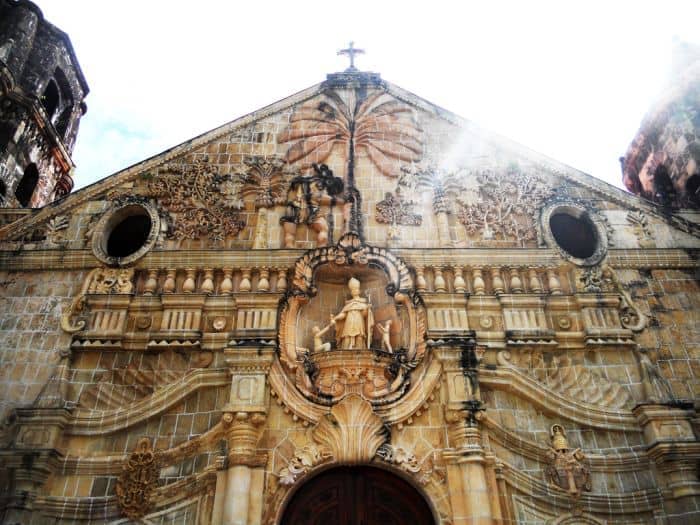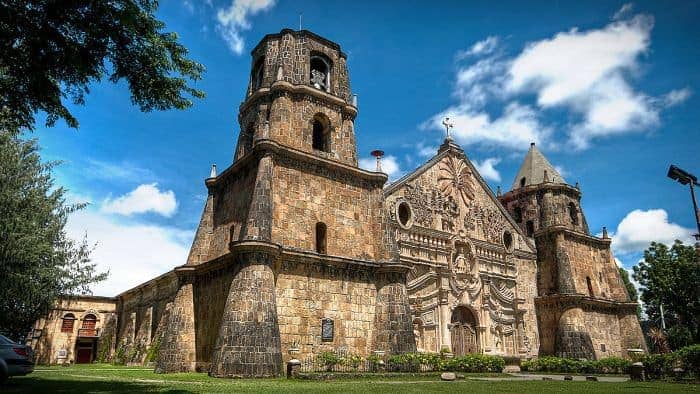 The Miagao Church, also known as the Santo Tomas de Villanueva Parish Church, is a Roman Catholic church located in Miagao, Iloilo, Philippines. It was preceded by two other churches: the first near the Tumagbok River in Ubos; the second on the same site and built in 1747 by the parish priest. Unfortunately, both were burned and plundered by Muslim pirates, so the townsfolk decided to build something stronger, this time on the highest ground, where they could have a commanding view of the mouth of the Miagao river, the usual route how the pirates made their way into town.
The Miagao Church, also known as the Santo Tomas de Villanueva Parish Church, is a Roman Catholic church located in Miagao, Iloilo, Philippines. It was preceded by two other churches: the first near the Tumagbok River in Ubos; the second on the same site and built in 1747 by the parish priest. Unfortunately, both were burned and plundered by Muslim pirates, so the townsfolk decided to build something stronger, this time on the highest ground, where they could have a commanding view of the mouth of the Miagao river, the usual route how the pirates made their way into town.
4.7/5 out of 101 reviews on google maps
The blocks of stones used in the construction of the church were quarried at Sitio Tubog in nearby San Joaquin town and in the mountains of the town of Igbaras. The adobe used in building the church is made from silt and clay that can only be found in this part of Iloilo, giving the building a unique warm-yellowish glow. This ochre color is also attributed by the egg, coral and carbonaceous limestone used in its construction.

The overall style falls under Baroque Romanesque, but is also influenced by Medieval Spanish, Chinese, Muslim and local traditions and elements, giving the church façade unique characteristics. It was not built by real architects but rather by friars who came as missionaries from Acapulco. This absence of western architect gave the friars the artistic leeway to seek the guidance of native maestro de obras (master builders), who thought more practically in terms of the tropical climate, frequent earthquakes, typhoons, fire, and marauding pirates.

Like a few other churches of this period, it more or less acted as a military fortress with a fancy facade and interior. As stipulated under Royal Decree 111 of 1573 (Law of the Indies), the church’s foundation is 6 metres deep with massive stone walls 1.5 metres thick, reinforced with 4 metre thick flying buttresses, typical of the “earthquake baroque” design applied in Ilocos churches, particularly Panay Church and Vigan Cathedral.

The façade consists of an ornately decorated bas-relief in the middle of two huge watchtower belfries on each side. It includes a coconut tree depicting the tree of life held by St. Christopher, who is dressed in local and traditional clothing while carrying the Child Jesus on his back. The rest of the façade depicts the daily life of the locals during that time and includes native flora such as papaya, coconut and palm trees.

Belltower
The two huge belltowers attached to the main church served as watchtowers defending the town against invaders and have different sizes and designs because they were commissioned by two different priests.
Baptistery
The baptistery contains the image of the Birhen ng Barangay in limestone and traditional Filipino clothing recovered from the 1982 excavations.

Unfortunately, the church was to suffer a few more calamities, burned in the Spanish revolution of 1898, a fire in 1910, the Japanese occupation during the second World War, and an earthquake in 1948. This was the strongest ever to hit Panay, toppling the bell tower of Jaro, the old church of Oton and many other Spanish-built churches on the island. However, only a small portion of a concrete beam gave way in the Miagao Church, releasing some stone blocks loosened by the heavy tremors.

It underwent another period of restoration in 1960 by the National Historical Institute, completed two years later when it was declared a national shrine by Presidential Decree. Now, 206 years old, the church stood the test of time and is one of the few remaining ones in the country, declared a UNESCO World Heritage Site on December in 1993 under the collective title Baroque Churches of the Philippines, and described as the finest examples of a fortress baroque church.

The Miagao Church is so well-known now that its pictures could be found in stamps, calendars, books and magazines. Its fame possibly helped by the former First Lady, Imelda Marcos when she attended the installation of Pope John Paul II, presenting him with a painting of this ancient church.
Getting there
Only 30-45 minutes away from Iloilo City, you can catch any number of several bus companies (such as Manila-bound buses, Dimple Star Transport, Gasat/Valisno Transport, and Ceres Liner), passing by the Miagao municipality every day. Ceres Liner by Vallacar Transit passes by Miagao almost every 30 minutes on its way to Iloilo from Antique and vice versa.
Jeepneys run more frequently (every 10–20 minute) than buses, the town served mostly by Miagao-Iloilo City bound jeepneys, but also the San Joaquin-Iloilo City bound jeepneys also serve the area.

But since there is so much to see on Panay Island, could be a suitable pitstop of your tour around the island, like we suggest in the map above. Of course it will give you the opportunity to see the famous Boracay Island, and if you have enough time, you can even visit Guimaras Island where we live, as there is lots to see there as well.
We have put all our contacts on these pages, so feel free to explore the area, but if you’d like any particular advice, or meet up, or perhaps stay at our airbnb, send us a note!
And if you have even more time, you can check out our island hopping boat tours in the Palawan area.
 Experience the thrill of island hopping in the Philippines
Experience the thrill of island hopping in the Philippines
Our reviews:

Home » Visayas » Panay »
You may also like:
We are a family operation managing private custom boat tours in the beautiful Palawan area, and are happy to help travelers with their plans through the country, having traveled a lot of it ourselves and planning to visit it all.












